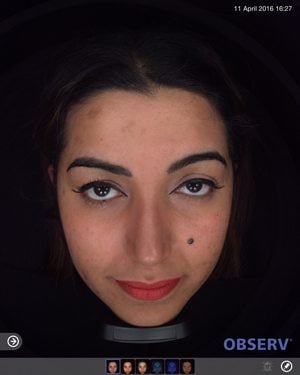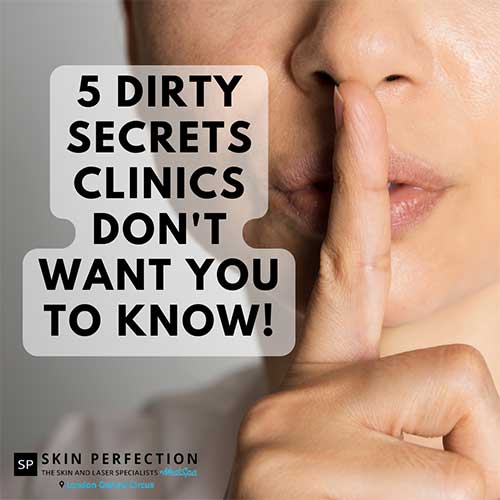What chemicals do skin peels contain?
Our skin peels have naturally-derived ingredients including:
- sugar cane (aesthetically known as Glycolic to help open pores, blackheads and ageing skin)
- salicylic acid (a natural form of aspirin, to help control breakouts, excess oil and is a natural anti-inflammatory to calm redness)
- malic acid, which is derived from apples
- pumpkin pulp
- mango and
- lactic acid, derived from sour milk.
How does the treatment work?
The practitioner first cleanses the skin before applying the peeling product.
The timing of the treatment will vary according to the product type and depth of peel required but will range from 3 to 20 minutes on average. During this time you will feel a sensation of mild warmth and tingling to a more intense heat.
A cooling device at Skin Perfection, by your skin specialist will be used if you feel you need it, to make your peel more comfortable and easier to manage. The practitioner will monitor your comfort and the effects of the product on the skin throughout the treatment, after which the product will be neutralised and removed.
Some peels may not need deactivating or neutralising as they self-deactivate, which makes sure the skin is completely calm before you leave.
We then apply post-treatment skincare products to cool, soothe and protect your skin.
What happens after the treatment?
Depending on the depth of peel, the skin may appear slightly pink or, in the case of a more invasive peel, a more profuse reddening of the skin may occur.
However, in general our patients can leave the clinic without feeling self-conscious. You may find that the use of moisturiser and our medical-grade, mineral makeup helps with the effects and post-treatment appearance of the peel.
No matter how deep the peel, your skin will re-grow and should heal fully as long as you follow the post treatment advice and do not pick at or pull off the dead skin.
If you choose to have a deeper peel – maybe to get rid of wrinkles or acne scars – when the skin re-grows, it will not 'remember' the blemishes that were there before.
As the new skin develops, a new band of collagen in the dermis will grow along with a thicker epidermis. Hence, the skin will appear smoother and more perfect than before the treatment.
Please remember that it is essential to wear a high SPF, even on cloudy days – as this is ‘brand new’ skin and should be treated accordingly.
Is there any downtime?
Peeling treatments do, by nature, incur a level of downtime as the skin reacts to the procedure.
While for the very superficial peels this may be almost indiscernible, for medium to deep peels the downtime includes varying levels of skin sheathing or shedding, skin discolouration, scabbing and irritation.
The post-treatment skincare product given to you by your Skin Perfection practitioner is essential to make sure that downtime is kept to a minimum and the skin’s healing processes are fully supported.
Do skin peels hurt?
When first applied to the skin, you may notice a slight tingling sensation, after which your skin will feel glowing and warm.
Will I be able to go out in the sun after a peel?
It is always recommended you wear a sun protection cream afterwards, of at least SPF 50, even in the winter. The skin is more susceptible to damage for 4 weeks after a peel, so it is not good practice to have a peel and then go into the sun during this period.
Because we know that the sun causes so much ageing and damage to the skin, we advise all patients to wear sun protection permanently.
If you are going on holiday to a hot climate we recommend that the peel is done after your holiday, not before. If it needs to be before, then we recommend you allow adequate time before the holiday and to make sure you fully protect your skin from the sun.
Are the peels good for scarring?
For the patient who wants to improve scarring, such as from acne, the peels are very successful.
However, it may take more than one peel for the optimum result and therefore a longer period of time is required for this treatment.
For scarring, we may recommend you have between 3 and 6 peels, spread over 6 to 18 months.
Will the peel get rid of pigmentation marks?
A lot of uneven pigmentation marks caused by sun damage can be greatly improved by peel treatments.
Successful treatment of pigmentation, though, depends on the underlying cause being no longer prevalent. If the pigmentation is being constantly fuelled by factors such as hormones or medication, then the approach to the treatment will be controlled management of the condition rather than cure.
Can all skin types have a peeling treatment?
In the case of some of the more superficial peels, most skins will benefit unless they are very sensitive, inflamed or show signs of dermatological conditions.
However in the case of the deeper peels, your practitioner will categorise your skin on the Fitzpatrick Scale, which is a professional gauge of the level of brown melanin pigment in the skin.
This is because darker skins may have a tendency to develop post-inflammatory pigmentation as a reaction to the treatment, and may have a predisposition to forming raised and keloid scars.
However there are now peels on the market, which we offer, which are suitable for the darkest skin tones. Your practitioner will advise you accordingly at your consultation.
Do I need to prepare my skin beforehand?
Your skin type and the skin peel selected by your practitioner will determine what preparation you need to do before your skin peel.
For light peels, no preparation is needed.
But for more specialist-corrective peels, your skin will need preparation for a period according to your individual skin type:
- skin type one to three - 2 to 3 weeks
- skin type four - 4 weeks
- skin type five - 5 weeks
- skin type six - 6 weeks.
















